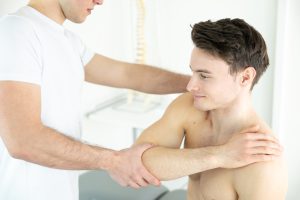
“I have read several of your articles related to myositis ossificans (a bone within the muscle), and I would need your opinion. I have been diagnosed with a calcification of 8mm in the belly of the triceps muscle caused by a hematoma that occurred on September 1, 2016.
I do not have any pain in the area where the calcification is, but it causes me significant discomfort in the form of a feeling of tightness in the elbow and noticeably weaker ability to use the triceps muscle, especially under pressure. According to the recommendation of an orthopedist, I underwent eight sessions of radial shockwave therapy, but I did not feel any positive effect after these sessions.
Currently, I am undergoing ultrasound therapy at the University Hospital Center Split. While reading one of your articles, I came across information that focused shockwave therapy has significant advantages over ultrasound therapy.”
A post-traumatic calcification in the muscle of the upper arm smaller than one centimeter should not cause any trouble. If there are symptoms present, it is much more likely that it is due to the connective tissue surrounding the calcification, which changes the direction of forces through the muscle, thus increasing tension in the elbow, rather than the calcification itself acting as a physical barrier. Shockwave therapy in calcifying myositis serves SOLELY for symptomatic treatment, meaning pain relief. It is NOT POSSIBLE to “break” such a calcification because it is not a buildup of calcium salts but rather a solid, live bone that has grown where it shouldn’t be. This means that we cannot expect its reabsorption after shockwave therapy. This reabsorption will occur spontaneously, but over a long period of time (several months, and sometimes years). In this light, the current ultrasound therapy also does not make much sense. If ultrasound therapy has not helped, it may be worth trying focused shockwave therapy, which can more precisely and deeply transmit energy with the aim of desensitizing local pain receptors.
However, more importantly than all of the above is to examine the shoulder and elbow and prescribe appropriate exercises to normalize muscle activation during movement and thus alleviate pain.
